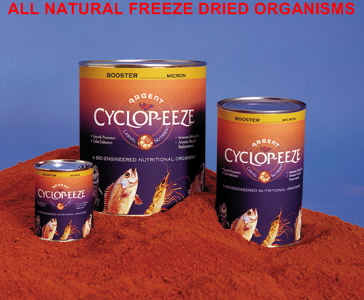|
A unique feed organism from Argent Aquaculture (formerly Argent Chemical Laboratories) provides an alternative or supplement to hatching Brine Shrimp Eggs.
Superior nutrition for Marine Reef inhabitants and ideally suited to zooplankton feeders. Also valuable as a nutritional supplement with superior color enhancing properties and high HUFA levels not found with
Artemia. Use on adult fish and Invertebrates as well as fry.
|
Discus fry feeding on Cyclop-eeze
CLICK on each image to enlarge
|
CYCLOP-EEZE is a new biologically engineered organism of the Copepod family. It has much higher concentrations of essential omega-3 fatty acids, biological pigments
and other nutrients than Brine Shrimp. This Artemia Nauplii substitute is available in freeze dried form and is a significant cost effective replacement for Artemia Nauplii
(newly hatched Brine Shrimp). The Freeze Dried product presents itself in powder form providing a convenient means of storage and application. The superior HUFA
levels make Cyclop-eeze an exceptional feed for many Marine Organisms especially useful in Reef Tanks.
This brilliant blood orange organism boasts the highest known concentration of w-3
highly unsaturated fatty acids, as well as the highest known concentration of biological pigments. The product is lyophilized (freeze dried), or Deep Frozen, to
retain these very sensitive nutrients. CYCLOP-EEZE therefore has much value as a color and reproductive enhancer for ornamental fish.
Cyclop-eeze are derived from the family of copepod grown in a pristine, arctic salina
in the north of Canada. Cyclop-eeze thrive during the short spring and summertime season. They forage on algaes rich in the highly unsaturated fatty acids (HUFA’s)
and biological pigments. More importantly, the Cyclop-eeze are busy synthesizers of HUFA’s, especially the important omega (w-3) variety. Argent’s previous research
showed that the pigments were simply accumulated by Cyclop-eeze in proportion to its abundance in their diets. The pigments protected Cyclop-eeze
from harmful photodynamic effects of visible lights. Argent’s research also showed that cold water temperature contributed positively to the brilliant orange color and
active behavior of Cyclop-eeze. The special salt lake (pH 9.7, Salinity 72ppt) where Cyclop-eeze grow is unique as it is very rich in a wide variety of inorganic chemicals,
several of which are important elements needed for the production of HUFA’s and biological pigments. Upon harvest, the Cyclop-eeze are immediately deep frozen so
that the important nutrients are retained. Shortly thereafter, the frozen blocks are taken to the Argent plant for freeze drying (lyophilization).
Cyclop-eeze are very rich in fatty acid (35%), especially the important fatty acid EPA(11.74%) and DHA (11.09%). By comparing with Artemia, Cyclop-eeze appear to be
a very good source of n3 (w-3) fatty acids. Many Breeders have found it neccessary or desirable to enrich their newly hatched Brine Shrimp with HUFAs to provide
adequate nutritional value. When switching to or supplementing with Cyclop-eeze (rich in HUFAs) this is no longer a concern. The fatty acid profile of Cyclop-eeze is
similar to that of menhaden fish oil used in dish diets. Cyclop-eeze are also rich in the 17 essential amino acids and minerals. The carotenoid data show that Cyclop
-eeze have very high astaxanthin concentration comparared with Artemia. A comparison between Cyclop-eeze and Artemia is shown in Table 1. Cyclop-eeze have been successfully used for pigmenting shrimp, rainbow trout, tropicals (Marine
and Fresh), etc. in many test feed around the world. 94% of the carotenoid of Cyclop-eeze is astaxanthin, which imparts the red hue to aquatic animals. The
astaxanthin accumulated in the skin of salmon and ornamental fish is mostly an esterified form of the carotenoid. Test feed reports of Cyclop-eeze showed that
dietary astaxanthin esters result in pigment depositions several times higher than either free astaxanthin or other pigment sources. Enhanced coloration effect (2%-5
%) is very evident through these studies. Growth enhancement is 15%-30%, and reproductive enhancement is 5%-15%.
CLICK HERE FOR FROZEN CYCLOP-EEZE
CLICK HERE FOR CYCLOP-EEZE TABLE (analysis comparison)
|



